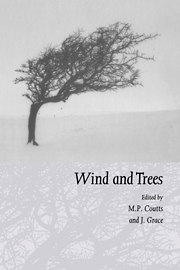Book contents
- Frontmatter
- Contents
- Preface
- List of contributors
- Part I Airflow over topography and in forests
- Part II Mechanics of trees under wind loading
- Part III Tree physiological responses
- Part IV Impacts of wind on forests and ecology
- 18 Hurricane disturbance regimes in temperate and tropical forest ecosystems
- 19 A comparison of methods for quantifying catastrophic wind damage to forests
- 20 Windthrow and airflow in a subalpine forest
- Part V Risk assessment and management response
- Index
20 - Windthrow and airflow in a subalpine forest
Published online by Cambridge University Press: 27 October 2009
- Frontmatter
- Contents
- Preface
- List of contributors
- Part I Airflow over topography and in forests
- Part II Mechanics of trees under wind loading
- Part III Tree physiological responses
- Part IV Impacts of wind on forests and ecology
- 18 Hurricane disturbance regimes in temperate and tropical forest ecosystems
- 19 A comparison of methods for quantifying catastrophic wind damage to forests
- 20 Windthrow and airflow in a subalpine forest
- Part V Risk assessment and management response
- Index
Summary
Abstract
A survey of the directions of coniferous tree windthrow in a subalpine ecosystem reveals a distinct relationship between the airflow and local terrain features. The survey covered a portion of the USDA Glacier Lakes Ecosystem Experiments Site (GLEES), located at an altitude of about 3300 m above sea level in Southeastern Wyoming, USA. The GLEES site is located in the lee of a glacial cirque basin in the upper treeline ecotone. The direction of the surface wind over the GLEES, as determined by meteorological data and the pattern of wind deformation of trees, is predominantly westerly. These winds result from channelling of larger-scale winds that blow around the south side of the mountain to the west of the GLEES. On the other hand, when the large-scale winds blow around the north side of the mountain, they may descend the ridge to the north of the GLEES at high speed from the northwest. The two modes of wind direction agree with observed bimodal windthrow directions.
Introduction
The Glees Project
The Glacier Lakes Ecosystem Experiments Site (GLEES) in the Snowy Range of Southeastern Wyoming is a 600 ha alpine and subalpine watershed at an elevation of 3200–3500 m above mean sea level (msl). Research at the GLEES is coordinated by scientists from the USDA Forest Service Rocky Mountain Forest and Range Experiment Station, the University of Wyoming, and the Medicine Bow National Forest. Nearly 20 cooperating universities and governmental agencies together with scientists from other countries conduct research on ecosystem and atmospheric processes at the GLEES which relate to climate change.
Information
- Type
- Chapter
- Information
- Wind and Trees , pp. 358 - 376Publisher: Cambridge University PressPrint publication year: 1995
Accessibility standard: Unknown
- 1
- Cited by
